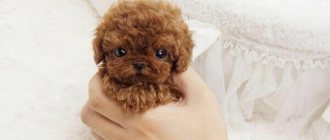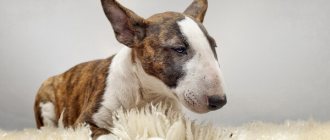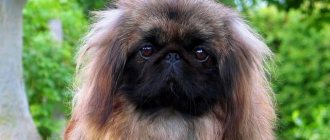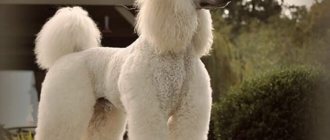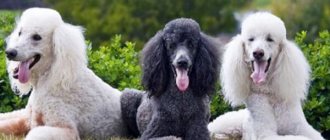The T-Cup Poodle is a miniature version of the Standard Poodle. They look very cute and attract the attention of animal lovers. Their peculiarity is their incredibly small size; in puppyhood, a poodle can even fit into a teacup. These babies can appear in the litter of even two standard-sized poodles. But the breed is still considered very rare, although it is very popular.
What types of haircuts are there?
Toy has a number of haircuts that will suit him:
- "Lion" which leaves a "collar" like a lion. Here the muzzle, hind legs, starting from the hock joint, a third of the tail, hips, croup and groin are shaved. The forearms on the forelimbs are also trimmed.
- “Modern” or “sheep shearing”. The muzzle, belly, throat, third of the tail and paws are cut to “zero”.
- The Pappy Clip trims the fur on the tail, soles and face. The intact hairline is shaped to one length.
- "Anglo-Saxon". The haircut for the front of the body is similar to that of the Leo. On the back, the hair on the face, throat, and paws is shaved. The lower back, croup and groin are not cut off completely, but 1-2 cm are left.
Content Features
It is difficult to imagine a more suitable breed for keeping in an apartment. The toy poodle is very small, clean, does not smell and does not shed.
The dog must have his own sleeping place, protected from direct sunlight and drafts. It should be quite spacious and comfortable.
Poodles are very active and energetic dogs, but their need for walks is quite easy to satisfy - they will be content with a leisurely walk in the park. It is especially good if there is an opportunity to run and play without a leash with the owner. In bad weather or severe frost, it is not necessary to take a toy poodle outside if he is trained to wear a diaper at home.
Poodles need a haircut not only from an aesthetic, but also from a hygienic point of view: sticky dirt and food debris in the fur on the face, between the toes and pads lead to tangles and skin diseases.
Already at a temperature of 0 -+ 5, toy poodles are cold and do not want to spend much time outside. To slightly extend the walk, which is necessary to maintain health, the dogs are dressed according to the weather.
A toy poodle would not be the best option for a family with small children, or for people who are constantly busy at work.
In addition, people who do not want to regularly pay attention to its appearance should not get a dog.
Nutrition
Toy poodles eat very little and only become capricious if they are pampered with goodies from early childhood. The owner chooses what to feed the toy poodle, natural or dry ready-made food, both options are acceptable. The natural diet is prepared according to standard recommendations for dogs. Industrial feeds are suitable for super premium or holistic class for dwarf or small breeds. Due to the tendency to allergies, you often have to experiment with the selection of diet.
You should not teach your dog to eat from your hand; it should get used to eating from its own bowl, into which a certain portion of normal healthy food is poured, and not just goodies.
Care
A poodle requires very troublesome care, which takes a lot of time and significant material costs. Given the tendency to dental diseases, it is recommended to brush your teeth once a day
For a poodle, it is important to choose good cosmetics that will suit the type of coat and not dry out the skin, because you have to bathe the dog often. Ears need to be cleaned once a week
Claws are trimmed as they grow, usually once every 3-4 weeks. You need to comb your poodle every day, at the same time inspecting the fur for tangles and rubbing the eyes, removing secretions accumulated in the corners. In white dogs, the tear ducts often have to be bleached with special means, especially in puppyhood. Excessive lacrimation is not typical for adult dogs.
Poodle haircuts
Grooming of poodles began much earlier than decorative dogs came into fashion, and this was done for the convenience of the animal while hunting waterfowl. Today, artsy haircuts are not only a necessity, but also a way of self-expression.
From early childhood, a poodle puppy becomes so accustomed to various hygiene procedures that sometimes an adult dog does not even have to be restrained - it sits and enjoys the manipulations. The basic poodle haircut is “Lion” and its modifications. Also popular are such hairstyles as “Modern”, “Continental”, “English saddle”, “Teddy Bear”. Dogs of this breed are groomed every 1.5-2 months and usually bathed once every 2-3 weeks. Is it possible not to cut your dog's hair?
It’s possible, but a poodle’s curly coat is constantly growing, and it’s difficult to say what he will look like in a year and a half. You don’t have to do a specific haircut or cut certain areas to zero, but you will definitely have to shorten the hair all over the body.
What are the pros and cons of the breed?
When talking about a dog like a toy poodle, the description of the breed includes both pros and cons. A black toy poodle or other color is presented as a plush toy that is not capable of being evil, but it still has significant disadvantages:
- It is characterized by increased cleanliness - the dog cannot live in dirt or be unwashed, otherwise it will begin to experience stress, become fat, or acquire various diseases.
- Top care includes monthly haircuts, constant combing of the coat, care of teeth, claws, eyes - in order to provide the dog with maximum comfort, you need to spend a lot of time.
- A small pet is more susceptible to various diseases, many of which are considered congenital.
- If you do not control the diet, the dog becomes fat, which is why various diseases may also develop due to the high load.
What are the advantages and disadvantages of the breed?
In addition to the listed disadvantages, there are also advantages that make this breed, even despite its difficult maintenance, a favorite of people:
- Due to their high intelligence, dogs are highly trainable;
- high social activity - they sincerely love the company of their owners;
- meek character - they are not aggressive, calm and affectionate;
- appearance - if you look at your pet for a long time, it may seem that the toy has come to life;
- hypoallergenic - their fur does not emit odor and does not shed, which becomes a gift for people with allergies.
Important! A dog of the toy poodle breed has important advantages, which makes it a full-fledged member of any family - they get along well with children and do not allow themselves to behave aggressively, so you don’t have to worry about the safety of the child.
Difficulties of care
The toy poodle is a dog that is kept only at home. An apartment or a private house is a suitable place for tiny pets to live. They prefer comfort and warmth.
There is no unpleasant smell or piles of hair from mini dogs. But this does not mean that the animal does not need to be looked after. To keep your pet healthy and cheerful, it is necessary to create comfortable conditions.
- The house should be warm, not lower than +17°C. The animal's place must be protected from direct sunlight. Drafts are detrimental to the health of a toy poodle.
- Walks with the dog are necessary, but not too long. If it is raining and cold outside, then it is advisable to refuse walking. It is good if the pet is accustomed to the house toilet (in a diaper).
- Monthly haircuts, bathing, daily brushing, ear cleaning and nail trimming are important in caring for your Toy Poodle to avoid mats in the coat, skin and other diseases.
- Daily brushing of teeth will help prevent dental diseases (toy poodles are prone to them).
- Mini poodles don't like being alone and get bored. It is advisable for people who are constantly absent from work not to own this breed. And if you had to go away, then you need to leave the baby a lot of toys so that he doesn’t feel lonely.
- For walks in cold weather, a curly-haired baby needs clothes, since he is already cold at +6 ° C.
Grooming a toy poodle, clothing, and food require considerable material costs. Before getting a puppy, you need to think about whether it is possible to provide the mini-dog with suitable conditions.
Of course, the owner himself can do the dog’s haircut; it’s cheaper than taking him to a hairdresser. But many owners are afraid or don't want to. In addition to a haircut, a poodle, like a terrier, a Chinese crested dog, and a small Japanese dog, must have their face shaved.
Origin
It has not yet been possible to reliably establish the time and place of origin of these miniature poodles. There are several popular versions of the appearance of such cute dogs. Some historians believe that small dogs appeared in France by crossing herding dogs, retrievers and shepherd dogs.
Important! Some historians believe that the breed originated in Central Asia. Later, miniature poodles were brought to Europe by sailors and received their modern appearance in European countries.
Modern miniature teacups were bred in the middle of the last century as decorative pets. Through selection, it was possible to achieve the smallest size of a regular poodle.
Dog food
Due to their small size, toy poodles eat little. But they are capricious and picky about food. Veterinarians advise combining natural food with premium dry food.
For toy poodles, like for any dogs, you need lean meat:
- turkey;
- beef;
- chicken.
From cereals, small dogs are given:
- buckwheat;
- oatmeal;
- rice
You also need to boil low-fat varieties of fish.
Eggs are included in the diet no more than once every 3 days. Occasionally treat the baby with fruit.
Note! Dry food and natural food are not mixed, but given at different meals.
You can't feed dogs by hand; it's hard to wean them off a bad habit.
The pet should have food bowls and a container with clean drinking water.
In addition, the animal needs vitamins. The veterinarian will tell you exactly which ones and how to take them. He will definitely need to show your pet to ensure its health and proper care.
Buying a Japanese Poodle
It’s more difficult with these comrades. There are few nurseries in our country that deal with this breed. But you should only contact them. The Japanese miniature poodle (his photo is presented above) is an expensive dog, and it is unlikely that puppies will be sold on free message boards.
It is important to pay attention! If they want to sell you a puppy with a shaggy face, something is wrong here. The breeder is trying to deceive, this is one hundred percent. Where are such conclusions from? The thing is that the highlight of the “Jap” is his shaved muzzle. Only such dogs are allowed to the exhibition.
You can ask the breeder for a Korean haircut for your baby. But this is done in advance, as a rule, with 100% prepayment. And sometimes, if the potential owner really insists on a haircut, the breeder is quite capable of refusing to sell him the puppy.
The breeder must dock the puppy's tail. But he will do this if the owner pays in advance.
Character and intelligence
All poodles are highly intelligent, easy to train and can master complex tricks with interest. When living in a family, the dog quickly remembers the basic phrases of those around him and begins to understand not only commands, but also speech addressed to him.
Toy poodles have a cheerful and active character. They become very attached to their owners and require a lot of attention. These dogs do not tolerate loneliness well, which is why they cannot remain alone in an apartment for a long time without damaging their psyche. If your toy poodle is forced to be alone during the day, you should have a second pet (dog or cat) with whom he can communicate. Otherwise, you cannot have this breed.
Attitude towards children and others
Poodles willingly take part in children's games, but only if this does not cause them any unpleasant sensations. When children try to force a dog to communicate, it may display its hunting nature and use its teeth. Because of this, adults should explain to the child that the poodle is not a toy, but a full member of the family that should be taken into account.
The toy poodle behaves friendly with other pets and quickly finds a common language with them. He will willingly communicate not only with dogs close in size to him, but also with large ones, as well as cats.
The Toy Poodle is friendly towards strangers. He will willingly play with guests if they want it, but he will not impose himself. The pet is indifferent to passers-by on the streets: he does not try to get to know them and does not show aggression.
Features of the Tee-Cap Poodle
For people who want to have a pet that can live well in a small apartment, dogs of this breed are ideal. They do not require much activity and are able to amuse their owners at any time with their touching appearance and unusual skills.
These mini dogs are highly intelligent and learn any commands well. They can be taught various tricks, and also be sure to instill in them the basic skills and basics of training. Otherwise, you can end up with a mischievous animal that will misbehave even at a conscious age.
In general, Tee-Cups have very attractive appearance, miniature size and good obedience, which makes them an ideal pet. Like other pets, they require a certain amount of affection and attention, as well as careful care and health monitoring. But for connoisseurs of this breed, such worries will not be difficult.
Similar articles
How to properly care?
This is a small breed that is distinguished by its cleanliness, lack of odor and shedding. Despite this, such a pet needs special care. Starting from a sleeping area, protected from drafts and direct sunlight, to grooming.
Grooming helps the poodle get rid of sticky dirt, tangles and food debris in the hair on the face. If it is enough to do a haircut once a month, then it is recommended to comb the dog, if not daily, then at least a couple of times a week. A massage brush and a damp towel will help with this.
The animal is exposed to water procedures more often than others, so you should not neglect bathing either (once every 5-8 weeks).
Since the breed is prone to various diseases, the condition of the claws, ears and teeth requires special control. For example, cleaning the ears serves as a preventive measure against otitis media, and examining and cleaning the teeth to remove tartar.
It is very important
If you decide to get a miniature Japanese poodle, you should be prepared for unexpected pet expenses. These dogs are very sickly. Starting from banal allergies and ending with complex diseases of the musculoskeletal system. This often happens: the dog is small, artificially bred. So all sorts of sores stick to the pet.
And one more thing: if the breeder refuses to demonstrate the pedigree of the puppy’s parents or does not want to introduce the potential owner to the mother of the litter, then refrain from buying a dog from this kennel. Not a single breeder whose reputation is well known in canine circles will refuse this to a buyer. On the contrary, he himself will offer to look at the pedigrees of the dog and the bitch from whom it is planned to get a puppy.
Poodle-Yorkie mix
Yorkipoo is another popular poodle mix, a charming but somewhat nervous dog that requires attention and needs early training. She gets her energy and temperament from the toy poodle, and her vocal abilities from the Yorkie. Remember that miniature dogs mature faster than large dogs (although they age more slowly), so you need to start training them at an earlier age. The main thing is to teach not to bark for no reason, but to voice only in a certain case. Otherwise, a loud dog will cause a lot of trouble.
By nature, Yorkipoos are active, playful and sociable. Children should be attentive to the pet - he does not like forced hugs or rough games. But he loves to chase the ball and play hide and seek.
If the mestizo has predominantly poodle genes, his coat needs simple care, because the pet sheds slightly. If the Yorkshire Terrier genes are dominant, daily brushing and trimming of hair on the face and in “sanitary areas” is required.
Photo of a cross between a poodle and a Yorkie:
Buying a European Poodle
Where can I buy a puppy, and how much will it cost?
Only in a specialized nursery. We remind you that they monitor the health of the animals there, and there is no risk of running into a dog in the style of “a mixture of a bulldog with a rhinoceros and a little bit of a mammoth.” That is, an inappropriate poodle phenotype will not be slipped in.
In addition, breeders always offer their supervision. You can call them and consult on various issues. And those owners who plan to exhibit their pets can consult on issues of interaction with the handler.
Do you want to breed a dog in the future? This is also decided through the breeder. There are a sufficient number of nurseries in Russia that specialize in breeding this breed.
How much do miniature poodle puppies cost? The price for a pet varies from 20 to 50 thousand rubles.
Character and features of training
A luxurious and aristocratic dog, which is usually depicted in proud poses in portraits, is in fact very active, inquisitive and agile. Large Poodle puppies are easy to train and copy the behavior of not only other dogs, but also people. You can start teaching basic commands from the first day the puppy is in its new home. It will be enough to repeat the command a couple of times for the young pet to remember it.
Since Royal Poodles are very intelligent and intelligent, they can be trained in any discipline. With the right approach to training, your pet can easily master the protective guard service (PSS) course.
Socialization must be timely, otherwise the puppy will grow up aggressive and unsociable. When training outdoors, the dog must be carefully monitored, and it is better not to let it off the leash until it learns the calling command. Hunting skills combined with excitement and curiosity can lead to an unexpected escape of a pet.
Large poodles have an impeccable sense of smell and can find their way home by following their own tracks, but in a big city many dangers await them and therefore it is better to keep a close eye on him during off-leash walks to avoid tragedy in the future.
A child over 12 years of age can be trusted to train a Royal Poodle. Cunning dogs, among other things, are excellent manipulators and can “twist ropes” out of children.
Description of the breed with photos
The prefix toy in the name means “toy” in English. Representatives of the breed outwardly correspond to this characteristic. The toy poodle has a proportional build, a joyful facial expression and a cheerful disposition. Sometimes toys are called small poodles.
- Head. The shape is correct according to the fox type. The forehead is convex, slightly oblong, of medium width. The eye arches are well developed, but do not give the muzzle a heavy appearance. The bridge of the nose is shorter than the forehead, straight. The jaws are quite strong with a full set of white teeth. Scissor bite.
- Nose. The size is proportional to the head. It looks flat from above, with a rectangular profile. The color of the lobe is black or matches the color of the coat.
- Eyes. Almond shaped. The eyelids are dense and colored. The color of the iris ranges from dark brown to golden amber. The look is interested, expressive.
- Ears. Hanging, close to the head. Rectangular shape with rounded ends. If the dog is interested in something, he lifts them slightly and turns them forward a little.
- Body. The poodle's build is correct, without unnecessary elongation. The scruff is pronounced. The withers are smoothed. The back is of medium width, tapering at the croup. The loin is pronounced. The croup is rounded. The transition line to the hip is smooth. The chest is oval in shape. The ribs are wide and springy. The front part of the sternum protrudes slightly beyond the front paws. The chest is lowered to the level of the elbow joints. The belly is tucked up, which gives the animal a sporty appearance.
- Tail. Set high, without bending. The breed standard allows for natural length or docking.
- Paws. Smooth, proportional to the body in length, with strong joints. Hips with pronounced smooth muscles, wide. The paw is collected tightly. There are small connecting membranes between the fingers. The toe pads and claws should be nose-colored or black.
Minor deviations in the appearance of a poodle from the standards are not a reason for culling, but will reduce the exhibition score. Dogs with severe defects are not allowed for exhibitions and are not recommended for breeding.
Size and weight
The weight and height of an adult dog depends on the category - toy or small toy. The first has a height at the withers of up to 28 cm, and the second does not exceed 25 cm. Poodles whose height at the withers exceeds 28 cm are classified as dwarf. The weight of the toy is from 3 to 5 kg. A small one weighs no more than 2 kg.
Coat type
The poodle's coat is curly, abundant, with fine guard hairs. It is elastic and resists compression. Less common are individuals with coarse corded hair, which is also allowed by the standard. The dog has no undercoat, as well as a dog smell. Poodles do not actively shed. They are hypoallergenic breeds.
Variety of colors
Toy poodle coat colors vary. The official breed standards have approved 6 options. Crossing dogs with different coat colors can produce puppies of unpredictable mixed colors. They are not suitable for exhibitions, but, due to their decorative nature, are very popular.
- White. Common and one of the most popular colors. This dog looks like a toy. The puppy may have a slight apricot or cream tint to the coat, which fades as it matures. A white dog's skin is pink or spotted. The nose and claws are black. The eyes are brown.
- Black. Refers to the classics. The wool should not have gray, brown, silver shades or a reddish tint. The nose, paw pads and claws are only black, without spots. Skin blue or gray.
- Chocolate (brown). The coat color is a uniform rich brown color. On the ears, the fur is slightly lighter than the base tone. The nose is brown. Eyes brown or amber.
- Silver. The coat is a smooth gray color. The adult coloration develops during the first 2-3 years of a dog's life. At birth, puppies are black. The silver color can be determined starting at 6 weeks. Nose, lips, eyelids black. Eye color is dark brown.
- Red. The main shade is mahogany (dark red). The color of the nose, eyelids and lips is brown or black.
- Apricot. Any apricot shades are acceptable. As the dog ages, it becomes lighter in color. Quite often, old dogs turn from apricot to cream. Skin color is pink, less often blue. The color of the eyelids and nose is brown or black.
Since 2007, two more color varieties have been recognized as the standard - white and black harlequin and black and tan. The second is a black poodle with small markings of any color.
How to choose the right puppy?
In childhood, toy poodles cannot be distinguished from larger varieties, so it is better to buy puppies from nurseries that have proven themselves on the positive side. Before purchasing, you should learn more about the nature of the breed, visit exhibitions, and communicate with current owners.
A responsible breeder will be happy to talk about his charges and inform about the characteristics of each of them - the puppies are always distinguished by their quality. He will not refuse to meet his parents. Dogs must have good conformation, behave in a balanced and friendly manner. Defects not only in appearance, but also in character are inherited.
After examining the litter, you should choose the most active and nimble baby.
His health is evidenced by:
- clear eyes;
- skin without redness or ulcers;
- a neat fur coat without an unpleasant odor;
- a body without any traces of excess weight or exhaustion.
The fact of purchase should be confirmed by a purchase and sale agreement in order to protect yourself from purchasing a mixed breed or a sick dog. Along with the document, the breeder must give the new owner a veterinary passport and the puppy’s birth certificate, which is subsequently changed to the pedigree.
Requirements for maintenance and nutrition
This enchanting beauty is not at all easy to care for. Wool requires special attention. If the dog is not given proper care, the thick strands become tangled, clump together and form tangles. In this case, you just have to cut off sections of the fur. Therefore, it is better to prevent such problems from occurring. Grooming includes the following procedures.
- A haircut. A poodle's coat needs to be trimmed periodically. This procedure is carried out every six to eight weeks. Before cutting your poodle's hair, you need to bathe it with shampoo, dry it well with a hairdryer and comb it out. The first time it is better to entrust the procedure to an experienced hairdresser. In the future, you will be able to maintain the beauty of your pet yourself.
- Grooming. The poodle does not shed at all, so you will never see your pet's fur on the carpet or sofa. Lost hairs remain near the skin. They subsequently serve as the basis for the appearance of tangles. Therefore, it is necessary to comb your pet once a week. For the procedure, use a special powder brush. Finish combing with a comb.
- Bathing. Despite the complete absence of dog odor, the poodle needs water treatments. They bathe the dog once every three weeks. To wash your pet's fur from dust and dirt, special shampoos and conditioners are recommended. You can use a hairdryer to dry.
- Ear and eye care. Once a week, it is necessary to clean the ears from accumulations of wax and dust with gauze swabs. Carefully monitor the condition of your eyes and wipe them if necessary.
- Teeth cleaning. Train your dog to brush its teeth once a week. This will protect against the occurrence of many oral diseases.
Daily walks with your pet should last about 30-40 minutes. It is not necessary to dress a poodle, because it has its own fur coat, which perfectly retains heat. But if the dog has undergone an extravagant haircut, as a result of which it turns out to be bald in places, then it is better to take care of it and wear warm overalls.
Features of feeding
You can feed your poodle with special food or natural products. Give preference to high-quality nutrition rich in vitamins and minerals. If the choice is on ready-made food, then it should be a premium product. When feeding natural products, the following rules must be observed.
- Meat. Makes up two-thirds of the poodle's total diet. Beef and lamb are healthy. An alternative to meat can be offal. They are given to the dog only in boiled form.
- Fish. Twice a week the diet is replenished with sea fish.
- Dairy products. A poodle definitely needs kefir, cottage cheese, and cheese, which replenish calcium in the body.
- Vegetables, porridge. Every day the dog should eat semi-liquid porridge made from buckwheat, millet, and rice. To replenish vitamins, the dog is given tomatoes, spinach, carrots, celery, beets, and cabbage.
It is difficult for a natural-fed pet to properly balance its diet. Therefore, veterinarians advise supplementing it with special vitamin and mineral complexes.
Breeding
This breed has many varieties. Therefore, when deciding to breed your pet, be sure to consult with experienced breeders. To get decent offspring, you need to have a good understanding of the genetics of poodles.
In order for a female dog to be able to bear a pregnancy and give birth to healthy puppies, veterinarians recommend breeding her only at the age of two. Despite the fact that puberty occurs very early in poodles (the first heat is around eight to ten months), the dog’s body is not ready for motherhood.
Pregnancy lasts on average two months. Childbirth is most often successful. But it’s better to play it safe and invite a veterinarian who will help your pet give birth and, if necessary, provide prompt assistance to her.
Read with this
- Poodles: description of breeds, types, care and training
- Medium poodle: features of maintenance and care
- When can you bathe a puppy?
- All about dog shedding
- Dog trimming
- Furminator for dogs
- How to sew a blanket for a dog with your own hands
- Description of the Yorkshire Terrier breed: pet character traits and owner reviews
- Labradoodle
- Master classes on dog grooming
